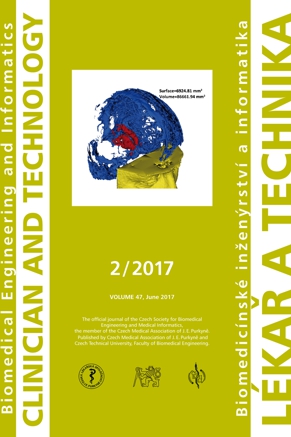MEASUREMENT OF THE VALUES OF RADIOFREQUENCY ELECTROMAGNETIC FIELDS AROUND THE HEAD OF ADOLESCENTS
Keywords:
adolescents, cell phone, radiofrequency electromagnetic fields, power measurement, questionnaireAbstract
Cell phones and other communication devices have become the primary source of socialization, especially among adolescents. The aim of the study was to assess the levels of radiated radiofrequency (RF) power (1788.5 MHz, max. 30 V/m) around the head of adolescents. The measurements were performed in 2016 at the Department of Medical Biophysics of Jessenius Faculty of Medicine in Martin. The sample group consisted of 44 adolescents of Viliam Pauliny-Toth, Grammar School in Martin. To measure the performance levels of electromagnetic fields (EMF), we used selective radiation meter NARDA SRM 3006 (9 kHz–6 GHz) with the function of a spectrum analyzer. The average values of power were recorded in eight positions around the head with six minutes exposure length of each of them. Every adolescent filled out a short questionnaire on personal perception of the effects of RF radiation on the body after the exposure. The statistical evaluation showed a significant decrease in the intensity of power on the left side of the adolescent’s head compared to the right side (p < 0.01–0.001), which confirmed different degrees of absorption by the head tissues. The highest level of absorption was measured at temporal area of the head connecting both ears. Shortterm exposure to RF radiation did not cause strong adverse health effects in adolescents, however in a few cases tachycardia, drowsiness, headache, fatigue and restlessness appeared. It is necessary to pay more attention to the examination of the relationship between exposure to RF EMF and the potential adverse health reactions mainly in adolescents.Downloads
Published
Issue
Section
License
Copyright (c) 2017 Hana Habinakova, Viera Jakusova, Miroslav Kohan, Jakub Misek, Jan Jakus

This work is licensed under a Creative Commons Attribution 4.0 International License.
Authors who publish with this journal agree to the following terms:
- Authors retain copyright and grant the journal right of the first publication with the work simultaneously licensed under a Creative Commons Attribution License (https://creativecommons.org/licenses/by/4.0/) that allows others to share the work with an acknowledgment of the work's authorship and initial publication in CTJ.
- Authors are able to enter into separate, additional contractual arrangements for the non-exclusive distribution of the journal’s published version of the work (e.g., post it to an institutional repository or publish it in a book), with an acknowledgment of its initial publication in this journal.
- Authors are permitted and encouraged to post their work online (e.g., in institutional repositories or on their website or ResearchGate) prior to and during the submission process, as it can lead to productive exchanges.
CTJ requires that all of the content of the manuscript has been created by its respective authors or that permission to use a copyrighted material has been obtained by the authors before submitting the manuscript to CTJ. CTJ requires that authors have not used any copyrighted material illegally, as for example a picture from another journal or book, a photo, etc. It is the author’s responsibility to use only materials not violating the copyright law. When in doubt, CTJ may ask the authors to supply the pertinent permission or agreement about the use of a copyrighted material.
The opinions expressed in CTJ articles are those of authors and do not necessarily reflect the views of the publishers or the Czech Society for Biomedical Engineering and Medical Informatics.


